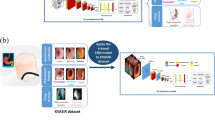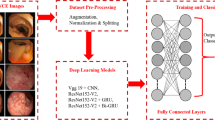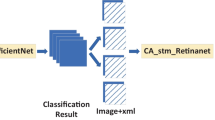Abstract
Background
This study was aimed to develop a computer-aided diagnosis (CAD) system with deep-learning technique and to validate its efficiency on detecting the four categories of lesions such as polyps, advanced cancer, erosion/ulcer and varices at endoscopy.
Methods
A deep convolutional neural network (CNN) that consists of more than 50 layers were trained with a big dataset containing 327,121 white light images (WLI) of endoscopy from 117,005 cases collected from 2012 to 2017. Two CAD models were developed using images with or without annotation of the training dataset. The efficiency of the CAD system detecting the four categories of lesions was validated by another dataset containing consecutive cases from 2018 to 2019.
Results
A total of 1734 cases with 33,959 images were included in the validation datasets which containing lesions of polyps 1265, advanced cancer 500, erosion/ulcer 486, and varices 248. The CAD system developed in this study may detect polyps, advanced cancer, erosion/ulcer and varices as abnormality with the sensitivity of 88.3% and specificity of 90.3%, respectively, in 0.05 s. The training datasets with annotation may enhance either sensitivity or specificity about 20%, p = 0.000. The sensitivities and specificities for polyps, advanced cancer, erosion/ulcer and varices reached about 90%, respectively. The detect efficiency for the four categories of lesions reached to 89.7%.
Conclusion
The CAD model for detection of multiple lesions in gastrointestinal lumen would be potentially developed into a double check along with real-time assessment and interpretation of the findings encountered by the endoscopists and may be a benefit to reduce the events of missing lesions.


Similar content being viewed by others
References
Knudsen AB, Zauber AG, Rutter CM et al (2016) Estimation of benefits, burden, and harms of colorectal cancer screening strategies: modeling study for the US preventive services task force. JAMA 315:2595–2609
Beg S, Ragunath K, Wyman A et al (2017) Quality standards in upper gastrointestinal endoscopy: a position statement of the British Society of Gastroenterology (BSG) and Association of Upper Gastrointestinal Surgeons of Great Britain and Ireland (AUGIS). Gut 66:1886–1899
Ahmad OF, Soares AS, Mazomenos E et al (2019) Artificial intelligence and computer-aided diagnosis in colonoscopy: current evidence and future directions. The lancet Gastroenterology & hepatology 4:71–80
Thakkar SJ, Kochhar GS (2020) Artificial intelligence for real-time detection of early esophageal cancer: another set of eyes to better visualize. Gastrointest Endosc 91:52–54
Min JK, Kwak MS, Cha JM (2019) Overview of deep learning in gastrointestinal endoscopy. Gut Liver 13:388–393
de Groof AJ, Struyvenberg MR, van der Putten J et al (2020) Deep-learning system detects neoplasia in patients with Barrett’s esophagus with higher accuracy than endoscopists in a multistep training and validation study with benchmarking. Gastroenterology 158(915–929):e914
Leenhardt R, Vasseur P, Li C et al (2019) A neural network algorithm for detection of GI angiectasia during small-bowel capsule endoscopy. Gastrointest Endosc 89:189–194
Xue H, Gong S, Shen Y et al (2014) The learning effect of a training programme on the diagnosis of oesophageal lesions by narrow band imaging magnification among endoscopists of varying experience. Digestive Liver Dis 46:609–615
Luo H, Xu G, Li C et al (2019) Real-time artificial intelligence for detection of upper gastrointestinal cancer by endoscopy: a multicentre, case-control, diagnostic study. Lancet Oncol 20:1645–1654
Chiu PWY, Uedo N, Singh R et al (2019) An Asian consensus on standards of diagnostic upper endoscopy for neoplasia. Gut 68:186–197
Ohmori M, Ishihara R, Aoyama K et al (2020) Endoscopic detection and differentiation of esophageal lesions using a deep neural network. Gastrointest Endosc 91(301–309):e301
Szegedy C, Vanhoucke V, Ioffe S et al (2016) Rethinking the inception architecture for computer vision. In: 2016 IEEE conference on computer vision and pattern recognition (CVPR), IEEE, p 2818–2826
Deng J, Dong W, Socher R et al (2009) ImageNet: a large-scale hierarchical image database. In: 2009 ieee conference on computer vision and pattern recognition, IEEE, p 248–255
Horie Y, Yoshio T, Aoyama K et al (2019) Diagnostic outcomes of esophageal cancer by artificial intelligence using convolutional neural networks. Gastrointest Endosc 89:25–32
Hirasawa T, Aoyama K, Tanimoto T et al (2018) Application of artificial intelligence using a convolutional neural network for detecting gastric cancer in endoscopic images. Gastric Cancer 21:653–660
Funding
This study was financially supported in part by the following funds: The innovation initiative of Sichuan University, Grant No. 2018SCUH0060, China postdoctoral science fund (2018M643503) and The science and technology project of the health planning committee (18PJ389), Linjie Guo received. Science & Technology bureau of Chengdu, China, Grant No. 2017-CY02-00023-GX, Zhiyin Huang received. Natural Science Funds of China, Grant Nos. U1702281, 81670551 and 81873584, Chengwei Tang received; National Key R&D Program of China, Grant No. 2017YFA0205404, Chengwei Tang received; Key research and development program of science and technology Department of Sichuan Province, Grant No. 2018GZ0088, Jing Li received.
Author information
Authors and Affiliations
Contributions
Conceive the idea and design the research: LG, ZH, JL, CT; Collect the information and image marking: LG, HG, ZH, JL, QZ, HT, XX, CL, JJ, BH; Artificial model-related work: QW, XL, JS; Write and revise the article: LG, ZH, CT.
Corresponding authors
Ethics declarations
Conflict of interest
Linjie Guo M.D, Hui Gong, BS, Qiongying Zhang, BS, Huan Tong, M.D., Jing Li M.D., Xue Xiao, M.D., Chuanhui Li, BS, Jinsun Jiang, BS, Bing Hu, M.D., Chengwei Tang, M.D. and Zhiyin Huang, M.D. have no conflicts of interest or financial ties to disclose. Qiushi Wang, PhD. Xiang Lei, BS and Jie Song, M.D. are shareholder or employee of the SeedsMed Technology Inc which provided CAD model in this study. Qiushi Wang, PhD. Xiang Lei, BS and Jie Song, M.D. had no role in the study design, data collection and analysis, decision to publish, or preparation of the manuscript.
Ethical Approval
This non-interventional study was reviewed and approved by the Ethics Committee of West China Hospital, Sichuan University (No: ChiECRCT20190176).
Additional information
Publisher's Note
Springer Nature remains neutral with regard to jurisdictional claims in published maps and institutional affiliations.
Rights and permissions
About this article
Cite this article
Guo, L., Gong, H., Wang, Q. et al. Detection of multiple lesions of gastrointestinal tract for endoscopy using artificial intelligence model: a pilot study. Surg Endosc 35, 6532–6538 (2021). https://doi.org/10.1007/s00464-020-08150-x
Received:
Accepted:
Published:
Issue Date:
DOI: https://doi.org/10.1007/s00464-020-08150-x




